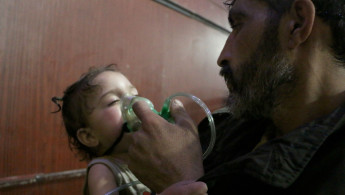Chlorine used in attack on Syria's Douma in 2018, says chemical weapons watchdog's final report
Chlorine was used in an attack on the Syrian town of Douma in April 2018, although there was no evidence of nerve agent, the world's chemical weapons watchdog said Friday in a final report on the incident.
The Organisation for the Prohibition of Chemical Weapons said there were "reasonable grounds that the use of a toxic chemical as a weapon has taken place on 7 April 2018.
"This toxic chemical contained reactive chlorine."
The long-awaited findings confirmed an interim report released in July on the attack, which medics said killed about 40 people when a cylinder containing poison gas landed on the roof of a housing block.
The report does not place blame because it was not in the OPCW's remit at the time, although the watchdog has since been given powers to investigate responsibility for all chemical attacks in Syria back to 2014.
Western powers led by the United States blamed the regime of Syrian President Bashar al-Assad for the incident and unleashed air strikes on military installations in response.
A team of OPCW inspectors took more than 100 samples from some seven sites in Douma when they gained access to the town several weeks after the attack.
The team also interviewed witnesses and carried out a series of tests including toxicological and ballistic analysis, said the watchdog based in The Hague.
Russia, which backs the Assad regime, swiftly rejected the OPCW report, saying that it was "staged" by Syrian rescue volunteers known as the White Helmets.
Moscow and Damascus have often accused the White Helmets and rebel groups of orchestrating chemical attacks, without providing credible evidence.
The watchdog rejected claims by the Syrian regime that the gas came from an alleged rebel chemical weapons facility and storehouse in the area.
The report will now go to the UN Security Council.
The OPCW has been at the forefront of investigating chemical attacks during the eight-year Syrian civil war, with investigators previously confirming the use of "chlorine, sulphur mustard, and sarin as chemical weapons" in other incidents.
A joint investigative mechanism between the UN and OPCW has accused Syria of using chlorine gas in at least two attacks in 2014 and 2015 and the nerve agent sarin in an aerial attack on Khan Sheikhoun in April 2017 that killed about 100 people and affected about 200 others.
The team also accused the Islamic State extremist group of using mustard gas twice in 2015 and 2016.





 Follow the Middle East's top stories in English at The New Arab on Google News
Follow the Middle East's top stories in English at The New Arab on Google News
![Israeli forces ordered bombed Gaza's Jabalia, ordering residents to leave [Getty]](/sites/default/files/styles/image_330x185/public/2176418030.jpeg?h=a5f2f23a&itok=_YGZaP1z)

